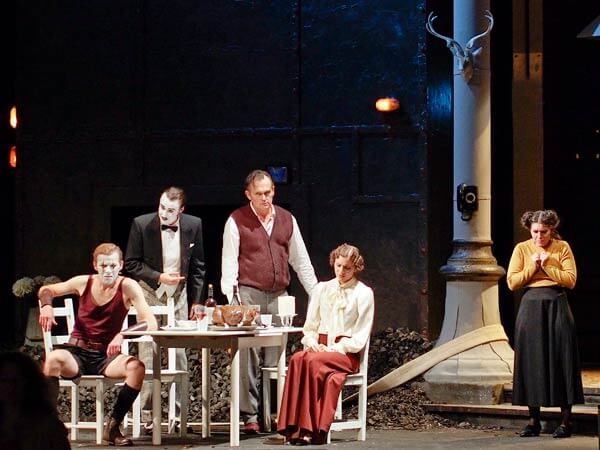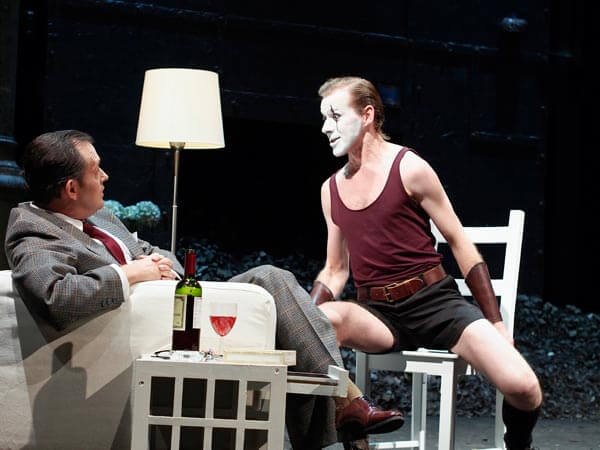

Biedermann und die Brandstifter cast members Tomasz Piȩtak, Till von Orlowsky, Stephen Chaundy, Barbara Zamek- Gliszczynska, and Katharina Tschakert at Neue Oper Wien (photo credit: © Armin Bardel)
In his setting of the play, Voseček has dispensed with most of Frisch’s “moral club,” as Voseček called it, trimming down the original text to make his own libretto. Removing the heaven and hell from this work changes the focus inward, creating a study of a character through every painful concession to morality on his downward spiral to facilitating an evil act. Given the lack of character development, this approach could have resulted in a fluffy opera: a character study with no depth of character provided for in the text. However, Voseček music amply filled in what the text left lacking. His setting is deep with emotional tension and release, frustration and hope. Though a composer fully-certified in the current pur et dur school of Viennese contemporary music, Voseček‘s opera is human and warm, lending new dimensions to Biedermann’s character throughout his journey from upstanding citizen to accessory to arson.
Musically, a combination of empathy and urgency was created through Voseček‘s stunningly beautiful instrumentation choices: three clarinets (two doubling bass clarinet); three trombones, one tuba; two percussionists; one violin and three celli. Well performed by the Amadeus ensemble-wien, we heard warmth from keening, sliding trombones and open, dissonant intervals in the celli and low brass. The clarinets provided urgent material in their altissimo range, whining very, very quietly in quarter tones about the danger lurking in the living room. The chorus of three sang almost exclusively in tight chords, differentiating them from the rest of the vocal material, which alternated between angular and smooth lines as the text required. The singing was uniformly excellent, with Stephen Chaundy performing a robust and stubborn title role. Barbara Zamek-Gliszczynska as Babette Bidermann sang a heart-breakingly gorgeous Goose Aria, her voice clear and solid, holding the neck of a dead goose while opining on her love for her husband. The role of Anna, the hard-done-by housekeeper was beautifully sung by Katharina Tschakert, who balanced the dramatic and comic aspects of her role well. Tomasz Piętak and Till von Orlowsky as Schmitz and Eisenring, the arsonists, sang these tricky roles subtly, allowing their evil to unwind slowly and naturally.

Stephen Chaundy as Gottlieb Biedermann and Tomasz Piȩtak as Josef Schmitz in Šimon Voseček’s Biedermann und die Brandstifter at Neue Oper Wien (photo credit: © Armin Bardel)
The space that Neue Oper Wien chose for this world premiere also helped to give a feeling of inward contemplation to the performance. Taking over the Semperdepot at the School for Visual Arts in downtown Vienna, the performance space consisted of a stage set up on the floor of a huge, five-story high concrete-and-brick cylinder. Built in the 1870s as a production and storage depot for the opera and theatre in Vienna, this space had enormous resonance, with a two- or three-second tail after every note. This fact mostly worked with the music. It enhanced the idea that we were exploring Bidermann’s inner stages of moral decay, hearing his thoughts echoing inside his own head. The space did work against the music at times- Voseček’s rhythmic percussion sometimes became muddied, overwhelming the lacy low-brass and cello writing underneath. The stage design and costuming were simple and effective, setting the piece in the play’s original period and adding comic touches when called for.
The real genius of Voseček’s setting became clear in the final scenes. By this time in the story, any sensible person would have woken up to the evil nature of the arsonists he had invited for dinner at home with his wife. The tension and absurdity of this dinner scene was made clear when the vocal writing changed from naturalistic, melodic, atonal material to single syllable utterances: Biedermann’s wife turned to Eisenring, who had been chit-chatting about a previous stint in jail. She asked slowly, “Why. Where. You. In. Jail?” The music focused around her words, stopping its frantic warnings for a bar to leave space for her frightening realization. We soon learned that Eisenring was jailed for arson, which he also spelled out for Biedermann in single syllables. And there it was, evil all laid out on the table. This musical device became a plot device, making it impossible to ignore the intentions of the arsonists to burn down Biedermann’s house. Biedermann’s choice to ignore these warnings became even starker in the face of this simple musical statement. Here, as throughout the opera, Biedermann’s inner turmoil was shaded in by Voseček‘s excellent writing, making this work so much more than just a morality play. This opera is an open question, pushing us to wonder more deeply about human actions.
